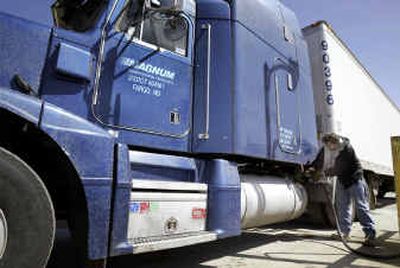Diesel prices stay high

WASHINGTON — Although gasoline has become more affordable since the start of summer, diesel and jet fuel prices are climbing steadily higher as autumn approaches, pinching truckers and pounding the already weakened airline industry.
Homeowners who heat with fuel oil also could face a big jump in their bills this winter. And the small but growing number of U.S. motorists who drive diesel-powered vehicles are shaking their heads in astonishment at the rising prices, since many were attracted to these cars and pickup trucks because of their relative cost advantage.
Retired airline pilot Jerry Puckett of Salt Lake City, Utah, said he used to save 20 to 30 cents a gallon when he filled up his diesel-powered Ford F-250 truck. But when he paid $1.93 a gallon at a Salt Lake City Flying J gas station Thursday, he noticed that the price of diesel fuel wasn’t going down.
“Boy, and I would like to know why,” he said.
The average nationwide cost for diesel fuel has risen 27 percent in the last year to $1.87 a gallon, according to the Energy Department. Unleaded regular gasoline costs about the same — averaging $1.85 per gallon across the country — but that is down about 10 percent from a peak of $2.06 a gallon in May.
Gasoline, diesel and fuel oil are refined from crude oil, which at roughly $45 per barrel has surged more than 60 percent in price in the last year. But because demand for diesel fuel continues to rise, in this case from trucking companies and other commercial users, the pricing pressure on that product has intensified.
Diesel prices are rising globally, analysts said, and that is influencing the domestic market. For example, rising demand and prices in Asia gives European refiners a financial incentive to send fuel to China, limiting the amount available for the United States to import. And analysts also suspect that a significant portion of the diesel produced in the United States is being sent to Europe, where prices are higher.
Economic growth in the United States has lifted over-the-road shipping demand by about 4 percent this year, mainly from the manufacturing and retail sectors, according to the American Trucking Associations. That has delivered higher earnings to the trucking industry. But the high price of diesel has also forced hundreds of tiny trucking companies out of business and squeezed the profits of larger players.
The biggest financial wallop resulting from higher prices of so-called distillate fuel — which includes diesel, jet fuel and heating oil — has been on the airline industry. Two of the nation’s largest carriers, UAL Corp.’s United Airlines and US Airways Group Inc., are in bankruptcy court and a third, Delta Air Lines Inc., is teetering on the brink of Chapter 11.
The turnaround plans at these carriers require either layoffs, labor concessions or some combination, but union officials complain that the burden of high energy prices has been unfairly placed on their members’ shoulders.
“We’re not the problem. Fuel prices went up,” Duane Woerth, president of the Air Line Pilots Association said recently. “We can’t help that.”
Within the trucking industry, the price surge has hit mom-and-pop companies the hardest, forcing at least 550 of them out of business in the first six months of the year, industry officials said, adding that the count does not include independent owner-operators, those with fewer than five trucks.